Enhancing Energy Efficiency, Detecting Faulty Devices, and Preventing Guest Misconducts Using Yabune Solution Ltd’s Smart Hotel Solution.
Introduction
The hospitality industry is continuously evolving to meet the demands of an increasingly eco-conscious clientele. As a result, hotels are adopting innovative technologies to minimize their environmental impact, enhance guest satisfaction, and ensure efficient energy management.
Hotels are fighting huge energy bills and better transparency over the energy consumptions is in high demand. Introducing new approaches can help the Hotels’ ownership understand the problems in their energy management. One such technology is the Yabune Solution Ltd.’s Smart Hotel Solution, featuring Home Assistant and Z-wave technology at its core. With its versatility and extensibility it has the potential to revolutionize energy management and maintenance in hotels by detecting faulty devices and preventing guest misconducts while potentially saving cost in both energy and manpower.
In this article, we will explore the benefits of Yabune Solution Ltd.’s Smart Hotel Solution, its implementation process, and the future of energy efficiency in the hospitality sector. Special thanks to Z-Wave Europe for providing the necessary sensors for this project.
Overview of the Yabune Smart Hotel Solution
Sensor Setup in the rooms
In our pilot phase we have started with one hotel and only 51 rooms, but in the last 3 years we have rolled out our solution to 4 hotels with 750 rooms all together. Here are some statistics:
- 2000+ relays (Shelly Wave 3 Pro, Shelly Wave 2PM)
- 1900+ sensors (Fibaro Smart Implants, Aeotec HEM 3Phase, MCO Home thermostats and presence sensors)
- 42GB+ energy and sensor data collected daily
- 6.7 TB sensor data collected over the last 2 years

In the below diagram, you can see the high-level design of the system in a standard Hotel Room. There are some other room types as well The solution is based on Z-wave technology, due to the large number of devices close to each other and the separation of the room is done on network level. Any mesh capable protocol would have been sufficient; however, we have decided to use Z-wave as it operates on 868 MHz in Europe and the chances for radio interference in a WiFi packed Hotel environment is low, compared to Zigbee which operates at 2.45 GHz, as it overlaps with the WiFi spectrum.
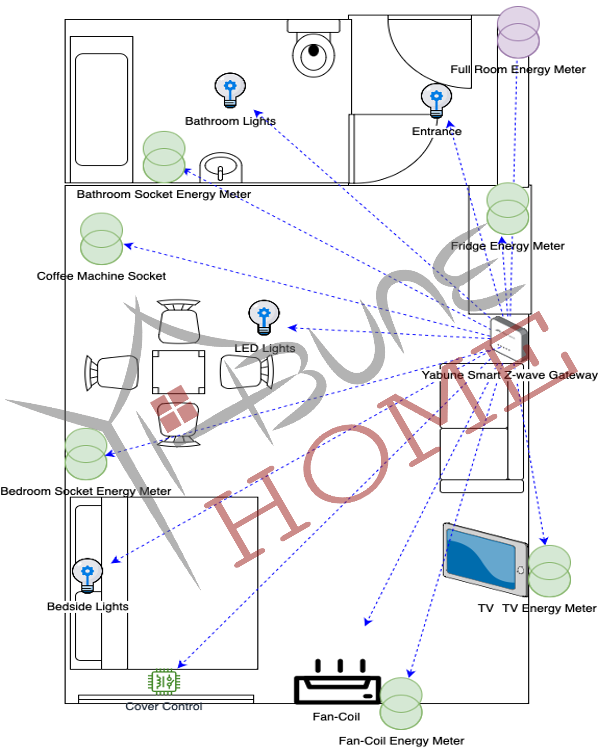
In the diagram we highlighted the circuits that are monitored by Aeotec HEMs (green current transformer symbols). Mainly we focused on the 24-hour circuits like TV, Fridge, and Fan-Coil, but also monitored the potential high consumption spots like Bathroom socket, Bedroom socket and the socket for the coffee machine/water heater.
We also took advantage of the Shelly Wave 2PM devices to measure separate circuits power consumption.
With the Shelly Wave PRO 3 relay boards we made it possible to control the different LED circuits, and sockets for up to 10 A, in case of endpoints with more than 10 A expected additional relays were added. It is true that the Shelly devices can support load up to 16 A, however in the hospitality industry reliability is the most important asset, so we really made sure and kept the devices well within their thresholds to improve longevity.
With the actuators in place, we could not just measure but actively impact the energy consumption of the room, to provide the potential for the full energy management solution.
We also measured the total energy consumed by the room (purple current transformer) to be able to give an estimate for the consumption of the rest like lights etc. in the room.
Two Aeotec HEMs were used per room, each with 3 60A clamps connected to the relevant circuit after the breakers. The clamps were inserted into a separate junction box as seen in the picture below:
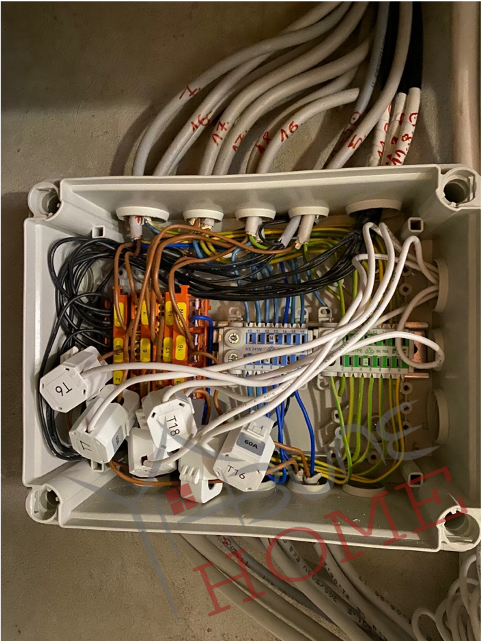
The 2 Aeotec HEMs were installed on the wall next to the box:
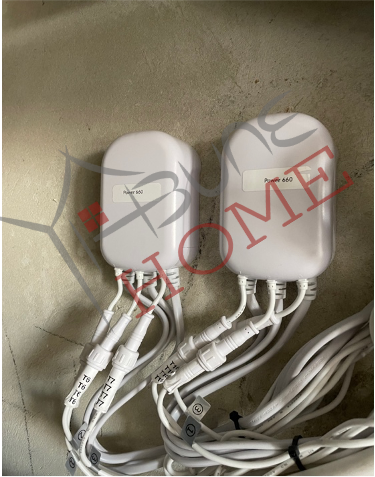
In the first phase we have applied this solution to 51 rooms in one Hotel. After the success of the first phase, we slowly with small modifications rolled out the solution to 750 rooms across 4 hotels in 3 years.
The relay board was installed into the main junction box of each room together with the rest of the smart room infrastructure. This location allows us to easily swap out faulty devices without interfering with the guests.

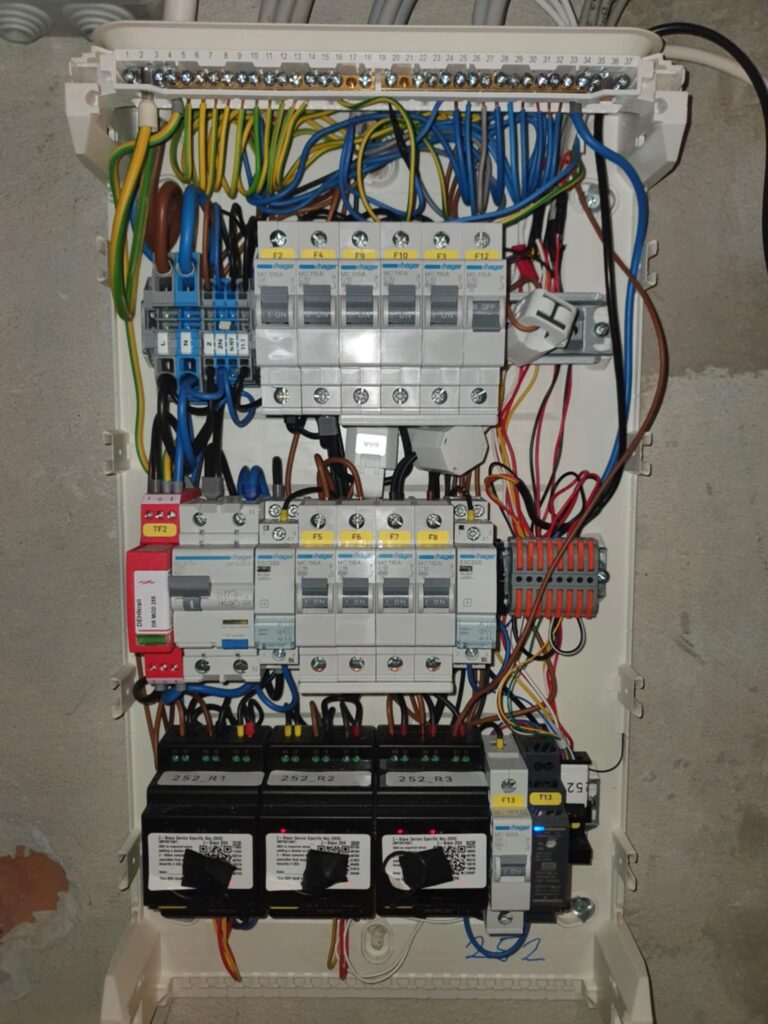
Yabune Smart Hotel IT infrastructure
The Yabune Smart Hotel Solution relies on mostly open-source solutions like:
- Zwavejs2MQTT
- Home Assistant
- Kubernetes
- Grafana Mimir
- Grafana
Our offering integrates these technologies to give the best and most accurate experience to our customers. With our approach it is possible to extend the solution for the needs of our customers efficiently. Our team consists of experts in edge computing, cloud technologies and Home Automation.
We have set up a centralized server solution running on a microk8s cluster in the hotel’s data center. This is responsible for processing the data and sending it to our data storage and metrics server in the cloud.
We deploy our custom built and configured Home Assistant as a cloud native app on the above-mentioned cluster, this improves scalability, maintainability, and observability.
We collect the data and communicate with the rooms using our custom Zwave gateway solution which is only responsible receiving the Zwave radio packets and converting them to IP packets over MQTT protocol.
Here you can see the high-level architecture of the solution:
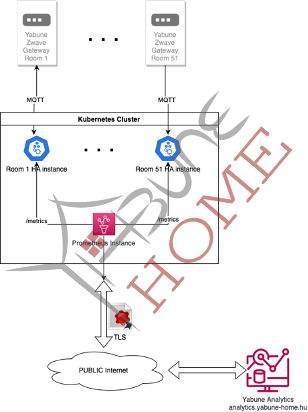
Custom Frontend to cater for the Hotel’s needs
After many meetings and discussion on what would benefit the most from the Hotel’s side, we have created a detailed Frontend configuration that supports the requested use cases the best.
As we support multiple Hotels within Danubius Hotels Group, we also created a landing page where the maintenance staff and other employees of the hotels with access can navigate. Each hotel has separate page with dedicated authorisation. When in the selected Hotel’s page there are also options to mass control the rooms, like setting the maximum heating target temperature, minimum cooling target temperature, disabling all towel heaters, setting all ACs, switching to ECO mode and switch between winter and summer modes. This option makes it really easy to manage large hotels as well with 200+ rooms.

These use cases cover the following:
- Easy overview of the rooms per floor
- Easy overview of the most important devices per floor
- Thermostats, window and door sensors
- Intuitive ways to navigate to individual rooms and have a detailed command center for each room with clear interface
Here you can see the Overview page:
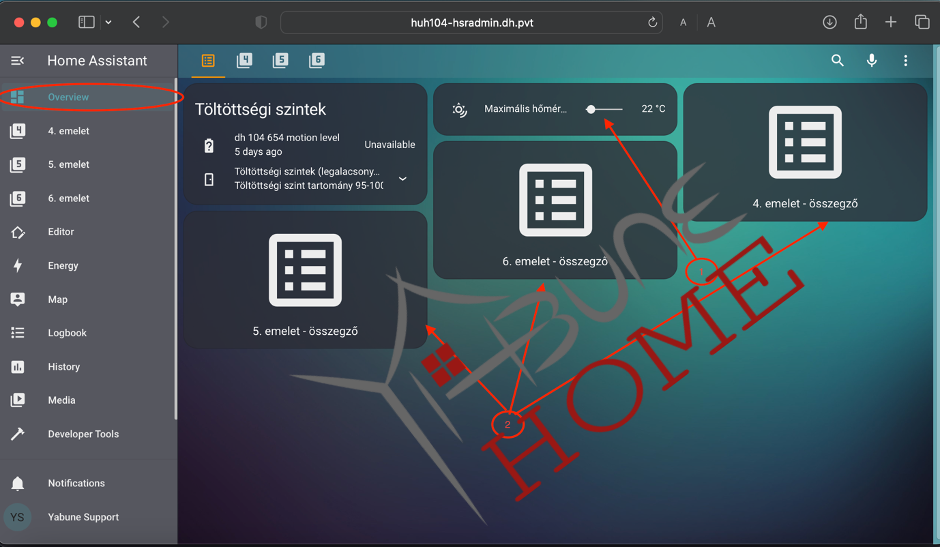
It allows the operators to select the Floor Specific View (2) and also provides information about the battery states across the rooms for the battery powered devices, making it easy to manage them if recharge is required (once every year or so). Additional custom configurations that impact all the rooms can also be set here as you can see with the slider (1). It sets the maximum allowed Heating target temperature for all rooms for better cost saving.
By clicking on one of the Floor Specific Tiles, you can get a summary for the selected floor:

This is a nice view to have an overview of the thermostats across the rooms. Grey color shows them in IDLE, blue in COOLING mode and red in HEATING mode. It is also possible to set the target temperatures from here. Scrolling down window and door states are also shown in the rooms:
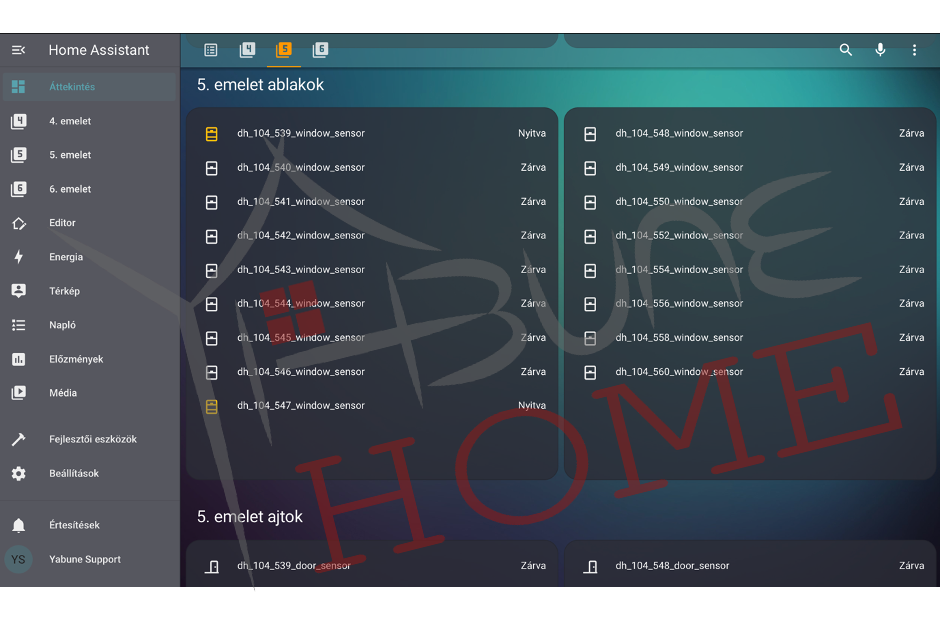
The summary page for each floor is also customizable to the need of the administrators.
Also it is important to have full control and overview of the individual rooms as well. We have organized the room tiles per floor as per request. By selecting the floor on the sidebar, it opens the View with Room tiles. Also highlighted the main sensors on the tiles like towel heater status, card status, window and door statuses and also presence sensor. So the Hotel staff can see these values at glance.
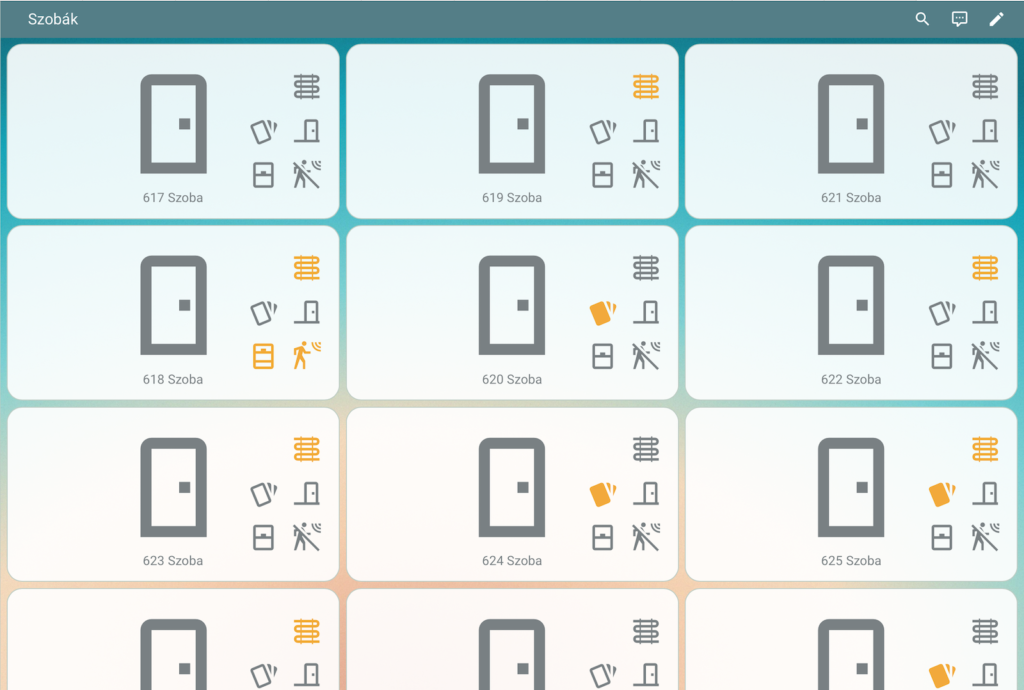
Clicking on any of the Room Tiles it brings the user to the Room Control Center:
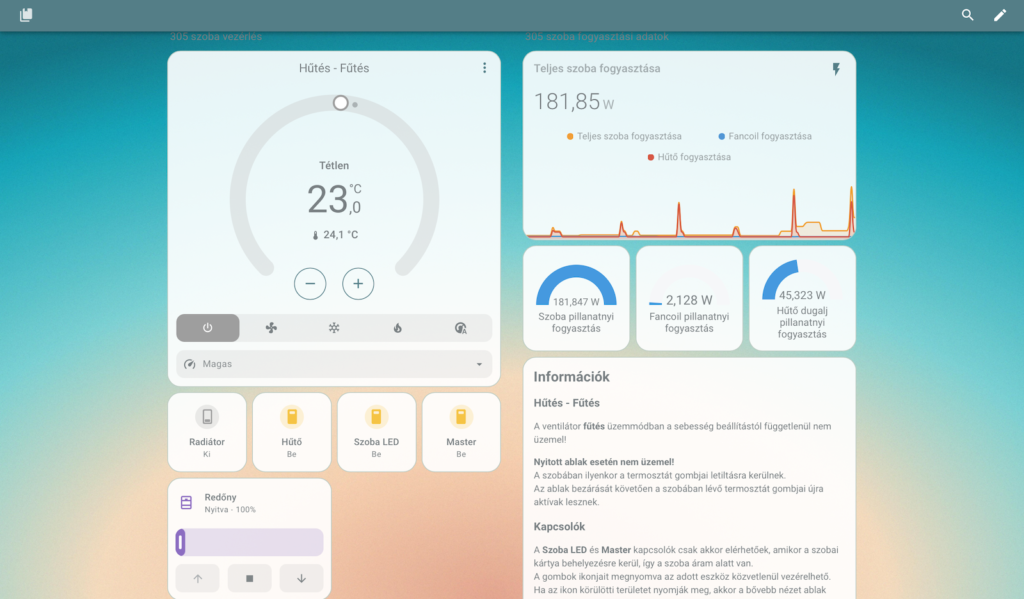
Here we have a lot of information about the rooms:
- Sensor list:
- Motion sensor battery and state
- Room temperature
- Room illuminance
- Window and door state
- Room card holder state
- Total energy consumption
- Thermostat
- Here the administrator can set the target temperature and also select the mode and the Fan Speed
- Energy Meters for the Utilities
- Real-time measurement of the 24h circuits (Fridge, TV, Fan-Coil)
- Also here it can be found the real-time measurement of the sockets (next to the bed, water heater, bathroom socket)
- Towel dryer control
- Turn on and off the towel dryer
- Light controls
We fully customized the panels for the Hotel it is possible to do it in any language, and also we provided description, so the hotel personnel can easily navigate the interface.
Automations to save time and energy
With the underlying Home Assistant interface and the combination of our microservices, it is possible to set up all sorts of automations. The triggers can be state changes of the sensors, time based, or event based or even external triggers such as checking in at the Front Desk.
One of the main benefits is that these logics can be easily adjusted and configured, for example we created an automation that switches the Fan-Coil to Fan Only mode in case of the guest is opening the window, but to protect the equipment there is a configurable delay after opening the window until switching the Fan-Coil to Fan Only. Once the window is closed it automatically turns back to the previous state (either cooling or heating). This way if for example the window opened and closed within this threshold, it won’t impact the Fan-Coil only if the window is open longer than the threshold.
Also we set up a configurable logic for the Towel heaters operated by an AEOTEC Nano Switch. The automation is the following, whenever the guest turns on any of the bathroom lights between 7 AM and 10 AM or 6 PM and 9 PM, the Towel Heater turns on and runs for an adjustable period. Only within the specified timeframe.
We have a large collection of possible automations from which the Hotel Owners can select the ones that they see the most benefit, however it is also possible to sit together and come up with new logics based on the Hotel’s needs.
Data Analysis and Visualization
Once we started collecting the data, we sat down with the Energy Specialist from the Hotel and discussed the key points what do they want to visualize, and how can we help with that. The outcome of the discussion was to create the following dashboards:
Energy Consumption Overview:
- In this board it can be clearly seen which floor consumes more. It is also visualized how this consumption spreads across the different consumers (TVs, Fridges… etc.)
- In the future we are planning to connect the system to the Oracle Opera PMS system, so it can be further fine-tuned to see how the consumption changes in relation to the room booking states.
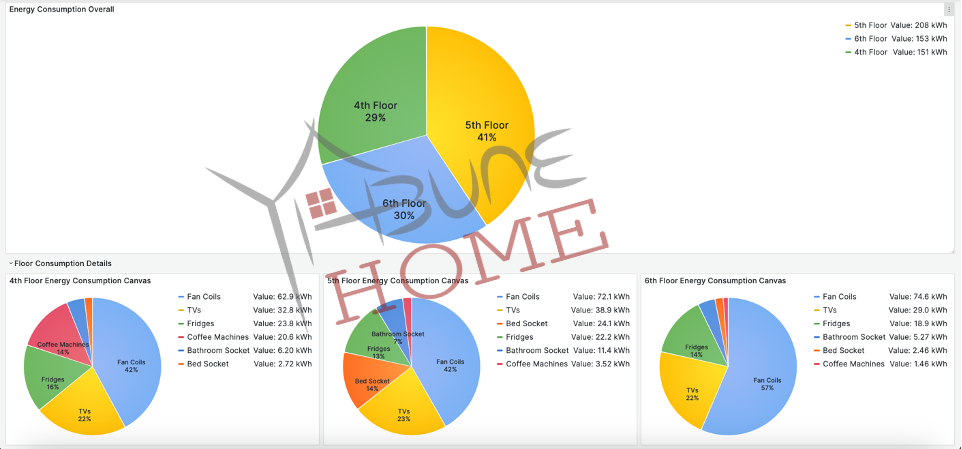
Energy Consumption Details per Floor and Room:
- With this view a given floors consumption can be monitored for selected time.
- The purpose of this dashboard is to help identify room anomalies either coming from sensor failures, or misbehaving guests.
- Our experience in the only 2 months of the project running so far, is that sometimes guests connect large consumers into the sockets, these cause extra cost for the Hotel but also brings fire hazard to the building.
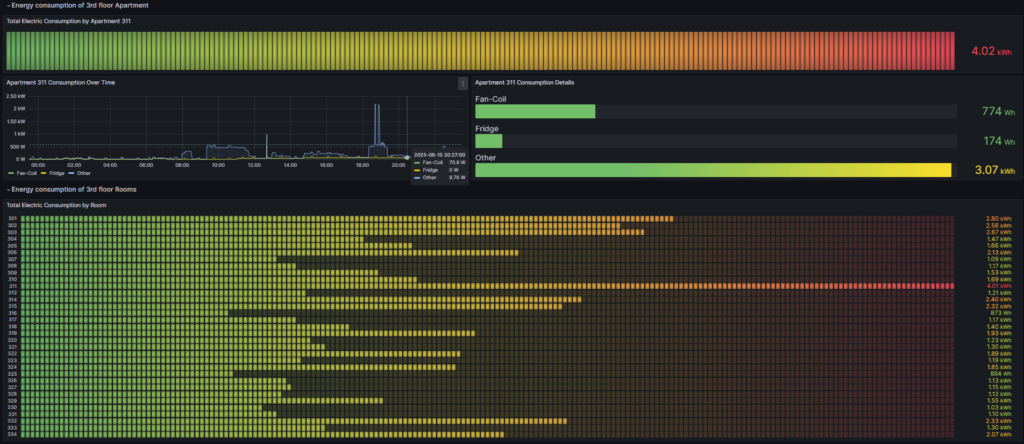
Energy Consumption Details for a specific Room
- With this view we can dig deeper into the given room’s energy consumption.
- Which circuit consumed more over the given period.
- This dashboard also shows the time series graph of the actual consumption to help better understand the user behavior patterns.
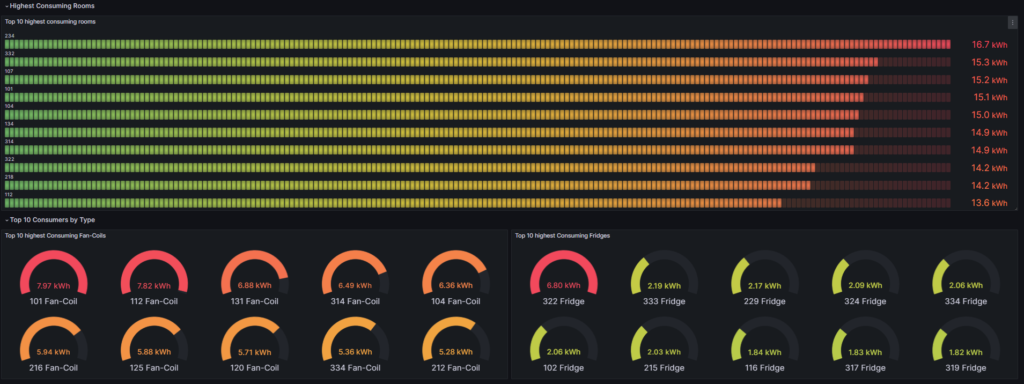
Highest Consumers per Circuit (like Fridges, TVs…etc)
- One of the main purposes of this view is to identify anomalies in the hotel rooms.
- A faulty equipment can cause increased energy utilization for given room, the sooner the hotel management identifies it and replaces the device the more is saved in energy costs.
- Also helps to understand guest behavior when it comes to TVs, Fridges, Fan-Coils and even Bathroom sockets.
- One of the main learnings so far is that the TVs consumption is significant compared to our devices such as fridges. This can give a nice initiative for the Hotel to select energy saving TV models even if their initial cost is higher, because the save in energy costs is measurable.



Heating Summary (based on the smart thermostats that are also part of the project)
- Heating and cooling are key part of any hotel. It contributes to the comfort of its guests, but also generates huge energy bills.
- In this iteration we only measure the energy consumption of the fans and the temperature values together with the status of the thermostats. It is planned to also measure the heating volume through measuring the temperature of the hot water pipes. We can already calculate some useful information about the operating hours of the fan-coils.

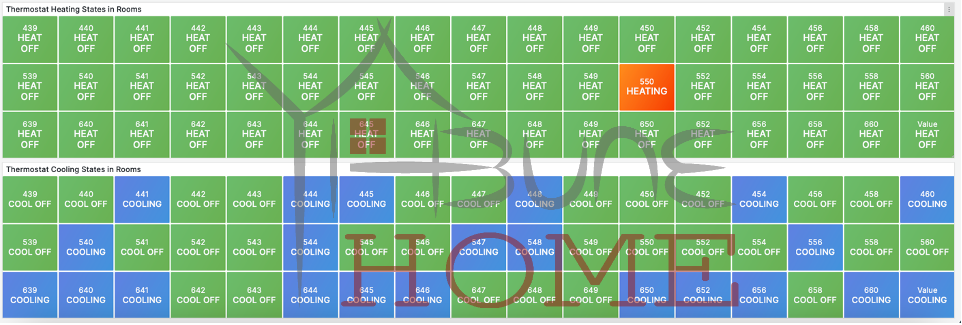
Heating Overview
- The purpose of this view is to identify the environmental impact of the rooms’ location on their heating and cooling patterns. Basically rooms facing SE heat up more during summer, hence require more cooling costing more money. The same is true during winter for the NW facing rooms in heating costs.
- The better we understand these impacts on the heating and cooling, the better we can adapt the Hotel’s heat management system to be more efficient.

AI driven anomaly detection
In our system with the large stream of data coming from hundreds of sensors, it can be hard to identify misbehaving devices. Here we use Cloud-based AI technology to identify outliers and either send notifications or streamline the data to make sure that it is always reliable.
The point of anomaly detection is to use Machine Learning algorithms on the data streams to identify outliers that are significantly deviate from the expected values. It can be done with thresholds, however thresholds need to be adapted continuously and that is where Cloud-based Machine Learning can aid us.
GPT-based Approaches
We are planning to introduce more AI-based applications such as data exploration using Large Language Models like GPT connecting to the data source. Also, recommendation system for energy saving using Machine learning algorithms.
Benefits of the Yabune Smart Hotel Solution
With the help of this offering, we can help Hotels’ to understand and improve their consumption characteristics in greater details. There are a lot of components to energy management, with proper energy monitoring we can aid decision making when it comes to the selection of electric devices, define processes on how to save more energy, by introducing intelligent handling of the devices and also identify anomalies in the hotel’s grid that needs to be evaluated like large consumers plugged into sockets by guests.
User experience can also improve by detecting faulty devices before it is reported by the hotel guests. We have seen multiple instances where fridge consumption in a room increased and after checking it, the maintaining colleagues found, that the device had a malfunction and started to overcool.
We are also working on new and modern ways to incentivize energy saving for the hotel guests as well by introducing gamification concepts to lower the energy consumption of the rooms. One example could be to give free cocktail for example for rooms who use energy below given limit daily… etc.
Special thanks
This project would have not happened with the forward-thinking management of the Danubius Hotels Group. We would like to also say thanks to Z-Wave Europe and Shelly for providing the large amount devices in a timely manner and helped us connecting with the AEOTEC support when needed.
Also special thanks to Shelly and Silicon Labs as they were supportive and proactive whenever we ran into issues with the Z-wave network or the firmware of the devices and also for the Z-wave Alliance to let us present our solution during the 2024 Barcelona event.
Projects of this size require proper planning and all partners were always eager to help and jump in to answer our technical questions.
Interested in Smart Hotels? Are you a hotel owner or work in relevant field?
Please fill out the form below and get in contact with us! We are expanding our Smart Hotel Portfolio. Apply so your hotel can be our next success story!

